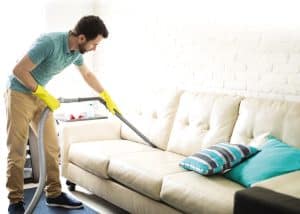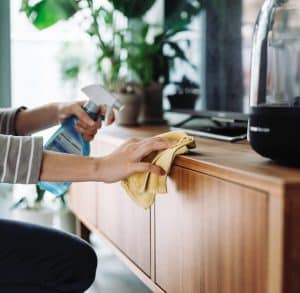 There is no better way to show your furniture appreciation for supporting you (literally) than to keep it well maintained. Freshly-cleaned furniture can help create a space that reduces stress rather than adding to it. Whether pet hair and dust have made a home on your favorite chair or you are just ready to get rid of that glaring stain on your couch, here are some of the best methods to clean your furniture based on its material.
There is no better way to show your furniture appreciation for supporting you (literally) than to keep it well maintained. Freshly-cleaned furniture can help create a space that reduces stress rather than adding to it. Whether pet hair and dust have made a home on your favorite chair or you are just ready to get rid of that glaring stain on your couch, here are some of the best methods to clean your furniture based on its material.
FABRIC FURNITURE
Fabric furniture can be some of the tougher pieces to clean in your home, but with the right knowledge, you can handle just about any mess. After initially clearing the surface of the fabric of any loose debris, move on to any nook in the furniture where crumbs, pet hair, and more can collect. Make sure that you detach or remove any pieces of the furniture that you can to get the best clean possible. Leather furniture especially can benefit from a thorough vacuuming, so go over your fabric surfaces using the brush attachment on your vacuum to get any more grime you may have missed. If you have pets, a lint roller can be a great option to remove any stubborn pet hair that may have been left behind by the vacuum.
Fabric furniture comes in a variety of materials with different needs when it comes to cleaning, but, luckily, there is an easy way to get a general idea of what you should be doing to clean your furniture. If you check the tag on your furniture, you will see one of the cleaning codes below, which can tell you what you should (and should not) be doing to clean it.
The most common codes are:
- W: Water-based cleaner. Spot clean using a water-based cleaning agent and avoid using any solvent-based cleaners.
- S: Solvent cleaner. Spot clean with mild water-free or dry-cleaning agents. Make sure you use such agents in a well-ventilated area and avoid using toxic chemicals like carbon tetrachloride.
- WS: Water/solvent cleaner. Use either a water-based cleaning agent or solvent cleaner. If using a solvent cleaner, clean in a well-ventilated area. It is recommended that you spot-test a less visible portion of the fabric with whichever cleaning agent you use to make sure that your cleaning agent of choice reacts well with the surface of your furniture.
- X: Vacuum only. Only vacuum or use a light brush on the surface of your furniture. Water and solvent-based cleaners could damage the surface of your furniture, so they should be avoided.
- D: Dry-clean only.
- WASH: Wash in your washing machine using the delicate setting and in cold water. Use a gentle dryer setting, such as tumble drying on low heat, or air dry.
 If you notice any stains that are not coming out while performing regular cleaning, you may then want to try a commercial stain-removing product as long as you pay close attention to the label and any instructions so that you do not damage the surface of your furniture. With leather furniture especially, it may be wise to try a safer DIY solution first before moving on to a stronger store-bought cleaning product. If you would like to try a DIY solution, try one of the mixtures below:
If you notice any stains that are not coming out while performing regular cleaning, you may then want to try a commercial stain-removing product as long as you pay close attention to the label and any instructions so that you do not damage the surface of your furniture. With leather furniture especially, it may be wise to try a safer DIY solution first before moving on to a stronger store-bought cleaning product. If you would like to try a DIY solution, try one of the mixtures below:
- For stains on leather upholstery, use olive oil and vinegar mixed into a spray bottle. Mist the stained area and clean it with a soft cloth.
- For stains on fabric upholstery, try a solution of vinegar, water, and either dish or castile soap mixed into a spray bottle. Mist the stained area and scrub with a soft cloth until the stain lifts. Then, use a damp cloth to remove the soap and dry the fabric with a towel.
- For stains on synthetic upholstery, use vinegar, warm water, and either dish or castile soap in a spray bottle. Mist the stained area and scrub it with a soft cloth until the stain lifts.
As a last step, you will want to dry off your fabric furniture either by using a dry towel to wipe up any excess water or letting it air dry. You will want to take extra care to make sure that your fabric furniture is adequately drying, especially if it is placed in a humid area, as you do not want to have a mildew problem on your hands. If you are worried that the furniture is not drying, you can use a box fan to speed the drying process.
OTHER FURNITURE
 For general maintenance, you will want to first wipe down the surface of your pieces to make sure they are free of any loose grime before deciding what the appropriate next step is. There are plenty of store-bought solutions to clean various materials. However, be sure to select the right solution for your furniture. There are also several DIY solutions for different types of furniture. It is recommended, however, that you first test your solution on an area of the furniture that is not visible to make sure that it does not impact the finish. If the spot-test you performed produced negative results, you may want to consider refinishing the furniture to restore it rather than doing something that could potentially damage it.
For general maintenance, you will want to first wipe down the surface of your pieces to make sure they are free of any loose grime before deciding what the appropriate next step is. There are plenty of store-bought solutions to clean various materials. However, be sure to select the right solution for your furniture. There are also several DIY solutions for different types of furniture. It is recommended, however, that you first test your solution on an area of the furniture that is not visible to make sure that it does not impact the finish. If the spot-test you performed produced negative results, you may want to consider refinishing the furniture to restore it rather than doing something that could potentially damage it.
On your wooden furniture, an easy DIY solution is a mixture of dish soap and water. For outdoor wooden patio furniture, you can use a mild oil-based soap to clean any stubborn spots that might linger. Commercial wood cleaners can also be a great solution as long as you pay extra attention to the instructions and make sure that you are properly treating your specific furniture. To maintain your furniture after cleaning, you can sand and apply finish to hardwood patio furniture on an annual basis to keep it at like-new quality. For wicker furniture, consider spraying down your pieces with a hose every few weeks to keep dirt and grime from building up in the crevices. For indoor wooden furniture, mineral spirits can help with larger buildups of grime. Of course, like with many store-bought solutions, you will want to carefully read the instructions to make sure you do not damage your furniture. You will also want to make sure you are working in a well-ventilated area.
 Glass elements in your home’s furniture can harbor some of the most noticeable grime and dust buildup. When wiping glass, make sure to use a soft cloth, such as microfiber, and avoid any rough materials that could leave scratches. Glass cleaner works great, or consider using white distilled vinegar for a DIY solution. Although far less susceptible to surface grime, wipe down the underside of glass tables every month or so to prevent dust particles from becoming ingrained. Once you are done cleaning, use a dry microfiber or similarly soft cloth to gently dry the glass surface. Additionally, you may wipe your glass with a balled-up newspaper to add an extra shine to your glass surfaces!
Glass elements in your home’s furniture can harbor some of the most noticeable grime and dust buildup. When wiping glass, make sure to use a soft cloth, such as microfiber, and avoid any rough materials that could leave scratches. Glass cleaner works great, or consider using white distilled vinegar for a DIY solution. Although far less susceptible to surface grime, wipe down the underside of glass tables every month or so to prevent dust particles from becoming ingrained. Once you are done cleaning, use a dry microfiber or similarly soft cloth to gently dry the glass surface. Additionally, you may wipe your glass with a balled-up newspaper to add an extra shine to your glass surfaces!
 If you find rust on your metal furniture, use a store-bought metal polishing paste to clean as much of it off as you can. For a DIY solution, you can use a 1:1 ratio of white vinegar and water. For more stubborn rust, you can use a sanding pad or steel wool for removal, taking care to avoid the surrounding areas. You will want to avoid using chemicals, such as ammonia and trisodium phosphate, as well as alkaline cleaners, which can produce rust. To clear your metal furniture of small scuffs, you can use a soft cloth with some nonabrasive cleaner. After you are finished cleaning, you can protect your metal furniture with a coat of car wax, or for added protection, consider a coat of rust-resistant primer and paint if applicable. Wrought-iron furniture can even be sand-blasted and/or powder-coated for additional protection to extend its life.
If you find rust on your metal furniture, use a store-bought metal polishing paste to clean as much of it off as you can. For a DIY solution, you can use a 1:1 ratio of white vinegar and water. For more stubborn rust, you can use a sanding pad or steel wool for removal, taking care to avoid the surrounding areas. You will want to avoid using chemicals, such as ammonia and trisodium phosphate, as well as alkaline cleaners, which can produce rust. To clear your metal furniture of small scuffs, you can use a soft cloth with some nonabrasive cleaner. After you are finished cleaning, you can protect your metal furniture with a coat of car wax, or for added protection, consider a coat of rust-resistant primer and paint if applicable. Wrought-iron furniture can even be sand-blasted and/or powder-coated for additional protection to extend its life.
 When picking a cleaner for plastic furniture, it is important to avoid using chlorine or bleach, which can actually eat away at the surface of the plastic. For a DIY solution, try either baking soda mixed with warm water or a mixture of vinegar and water for colored plastics. Mildew stains can be removed with white vinegar and a bit of elbow grease. For other stubborn stains, try baking soda and a wet sponge. If you go the route of using a store-bought cleaner, make sure to avoid using anything abrasive, as you might leave the surface of your patio furniture with unwanted blemishes in the process.
When picking a cleaner for plastic furniture, it is important to avoid using chlorine or bleach, which can actually eat away at the surface of the plastic. For a DIY solution, try either baking soda mixed with warm water or a mixture of vinegar and water for colored plastics. Mildew stains can be removed with white vinegar and a bit of elbow grease. For other stubborn stains, try baking soda and a wet sponge. If you go the route of using a store-bought cleaner, make sure to avoid using anything abrasive, as you might leave the surface of your patio furniture with unwanted blemishes in the process.
Regardless of the material of your furniture, you will want to make sure to thoroughly clean the surface of the piece before moving on to any further cleaning and err on the side of caution to treat each piece as needed. Thoroughly read any instructions, such as the tag on fabric furniture, that came with your furniture. If relying on a store-bought cleaning product, make sure that you read the label and any instructions extra closely so that you get the best results out of cleaning and do not damage the furniture. Also, consult a professional if you are unsure how to clean your specific furniture. Especially for unique pieces or furniture that was a larger investment, it would be better to get advice on how to clean rather than deal with damage caused by improper cleaning. While you may spend more up front, professionals not only save you the time and energy of cleaning your furniture yourself, but they can also save you from having to spend more to repair or replace damaged items.
Routine maintenance extends the life of your furniture and makes your home feel fresh. I recommend a deep cleaning once or twice a year or every 3-4 months if you have kids or pets. Having the knowledge of what to do as soon as you are faced with a pet mess or food accident can help you avoid stubborn furniture stains in the future. ![]()
Kent Carson
Home & Yard Magazine




